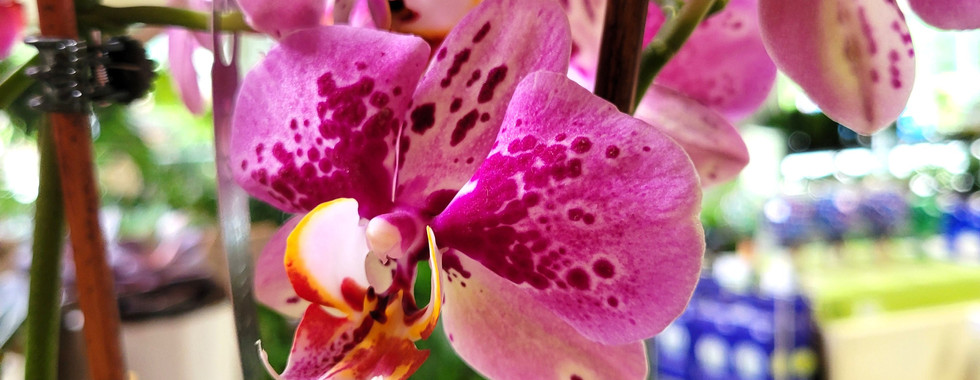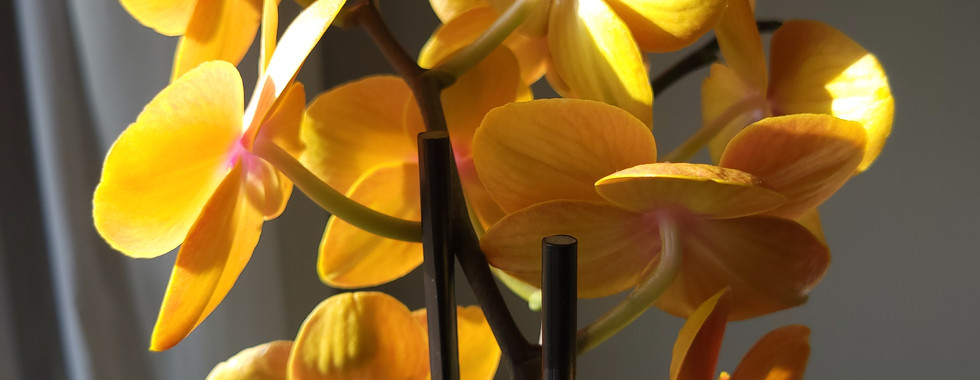Orchids- Plant Bio: Podcast Ep#119
- Owner: Holly Dz

- Sep 1
- 6 min read
Orchids are among the most beautiful, varied, and exotic plants in existence. The diversity of colors and shapes in Orchids is rapidly expanding, as cultivators strive to develop the newest and most exceptional varieties. While some people claim that Orchids can be quite challenging as houseplants, with the proper care, they can be incredibly rewarding.
Other Facts
Family: Orchidaceae
This is one of the largest families of flowering plants that exists
History: It is believed Orchids have been around for million years especially since Orchids have adapted to thrive successfully in many different environments around the world.
An Orchid could also live for 100s of years!
Flower: ALL Orchid flowers are bilaterally symmetrical
Flower: Orchids take about 5-7 years to bloom once germinated so Orchids that are blooming in stores are fairly old!
Flower: After Orchids are done blooming, trim the stem just above the first unused node. This will look like a small bump along the side of the stem.
Growth: Depending on the type, Orchids are either epiphytic (growing on other plants), lithophytic (growing on rocks), or they may grow in the ground!
Growth: The vanilla bean comes the Vanilla Orchid which is the only commercial grown and harvested Orchid plant.
Growth: Typically Orchids need to stay between the temperatures of 50 degrees F to 75 degrees F.
Growth: Root health is important for an orchid! Most varieties you are bringing home, will produce roots that end up growing outside the pot which is completely normal. If you notice them turning brown or squishy, it could be a sign that something isn't right. Removing those roots and keeping the thicker, healthier roots is helpful.
Growth: Medium is a hot topic for Orchids but, in my experience, it is heavily dependent on how you care for your houseplants. The most important thing is providing a medium that is very well draining and allows for some air circulation.
Notice the Orchids on clearance at the plant shop because they aren't blooming? If the leaves and the roots look healthy, that can be a steal!
Most Orchids are considered nontoxic to pets. That being said, please do your research on the certain cultivar before bringing it home! If you are interested in learning about more pet friendly plants, check out Podcast Ep#31 for more info or the corresponding blog post!
Orchid phalaenopsis (AKA Moth Orchid) Fail-en-OP-sis
This is probably the easiest of the Orchids to grow indoors. For that reason, this will be the most commonly found Orchid available at plant shops and garden centers. These bloom in winter time and the flowers can last for months if taken care of properly.
Sun Requirements
Bright, indirect light or medium light is all that is needed. Sometimes a direct South or West window can be too much if there isn't any shade but an East window is the most ideal location.
Water Requirements
These have low watering needs meaning they do like to dry out in between watering. They do not like to stay dry for long so it may take experimenting when that is within your home. This is also dependent on the medium you use as well.
Humidity Requirements
Extra humidity is preferred to help your Orchid thrive. Anywhere from 50-80% is good.
Fertilizer Requirements
This is dependent on your goals but usually Orchid owners want their plants to produce blooms. In this case, I would focus using a high phosphorus fertilizer where the middle number of the fertilizer ratio is the highest.
Orchid angraecum an–GRAY-kum
These are known to grow similarly to Orchid phalaenopsis.
Sun Requirements
Bright, indirect light or medium light is all that is needed. Sometimes a direct South or West window can be too much if there isn't any shade but an East window is the most ideal location.
Water Requirements
These have low watering needs meaning they do like to dry out in between watering. They do not like to stay dry for long so it may take experimenting when that is within your home. This is also dependent on the medium you use as well.
Humidity Requirements
Extra humidity (55-85%) great to help these Orchids thrive but it not necessary. As long as you keep them watered as needed, you do not need to add humidity.
Fertilizer Requirements
A balanced fertilizer is all that is needed through the year but you can use a high phosphorus fertilizer once you start to see flower spikes forming.
Orchid cattleya (AKA Queen of Orchids) KAT-lee-a
These Orchids are classically used for corsages. Usually blooming in spring or winter, these are also considered one of the easier Orchids to grow indoors. These are also known to be fragrant bloomers.
Sun Requirements
Direct sun or preferred to allow these Orchids to thrive but they can also use bright, indirect sun.
Water Requirements
These have low watering needs meaning they do like to dry out in between watering. They do not like to stay dry for long so it may take experimenting when that is within your home. This is also dependent on the medium you use as well.
Humidity Requirements
Extra humidity (40-70%) great to help these Orchids thrive but it not necessary. As long as you keep them watered as needed, you do not need to add humidity.
Fertilizer Requirements
A balanced fertilizer is all that is needed through the year but you can use a high phosphorus fertilizer in the spring to help promote bloom growth.
Orchid oncidium (AKA Dancing Ladies) on-SID-ee-um
These are one of the easiest Orchids to get to bloom and they can bloom multiple times a year! The flowers typically don't get more than about an inch wide and are usually yellow.
Sun Requirements
Direct sun or preferred to allow these Orchids to thrive but they can also use bright, indirect sun.
Water Requirements
This is dependent on the variety but they typically have medium watering needs meaning they don't like to completely dry out in between watering. This is also dependent on the medium you use as well. Avoid watering the foliage and flowers as these do tend to have a higher chance of infections.
Humidity Requirements
Extra humidity is preferred to help your Orchid thrive. Anywhere from 30-60% is good.
Fertilizer Requirements
A balanced fertilizer is all that is needed through the year but you can use a high phosphorus fertilizer in the spring to help promote bloom growth.
Orchid paphiopedilum (AKA Venus's Slippers) paff-ee-oh-PED-ih-lum
With a flower that has a lower pedal that looks like a pouch, these are also considered a fairly easy Orchid to grow indoors.
Sun Requirements
These can tolerate a few different options but does best in medium or bright, indirect light.
Water Requirements
These have low watering needs meaning they do like to dry out in between watering. They do not like to stay dry for long so it may take experimenting when that is within your home. This is also dependent on the medium you use as well.
Humidity Requirements
Extra humidity is preferred to help your Orchid thrive. Anywhere from 40-50% is good.
Fertilizer Requirements
You can use a balanced fertilizer through the year or a high phosphorus fertilizer in the spring to help promote bloom growth.
Other types:
Orchid dendrobium
Orchid cymbidium
Orchid phaius
Orchid bulbophyllum
Orchid vanda
Orchid phragmipedium
Orchid catasetum
Orchid gongora
Orchid coelogyne
Orchid habenaria
Orchid cymbidium
Orchid lycaste
Orchid zygopetalum
Orchid masdevallia
Orchid miltonia
Orchid miltoniopsis
Orchid stanhopea
Orchid tolumnia
SUN TIPS: Check out Podcast Episode 72 or 63 , the Light Explained blog post, or the Grow Light blog post
WATER TIPS: Check out Podcast Episode 84 or the Water Explained blog post
FERTILIZER TIPS: Check out Podcast Episode 103 or the Fertilizer Explains blog post.

WANT TO LISTEN?
Go to Apple Podcasts, Spotify, Stitcher, Google Podcasts, and more! Search for Houseplant Homebody to hear this episode and MANY more! You can also listen directly on my website under the Podcast page!
DON'T FORGET TO FOLLOW!
Stay connected on Instagram, Facebook, and Pinterest @houseplanthomebodyllc.
SAVE, COMMENT, LIKE, FOLLOW, SUBSCRIBE, and SHARE.
All your engagement on my podcasts, blogs, and social media posts help other plant lovers find me too!
Always written with extreme plant passion!
Love, Holly (Owner & Creator of Houseplant Homebody LLC)
SOURCES:















































































Comments